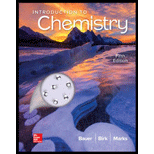
Concept explainers
What are the empirical formulas of the compounds with the following compositions?
(a)
Interpretation:
The empirical formula is to be determined.
Explanation of Solution
The simplest positive integer ratio of the number of constituent atoms of a compound is known as its empirical formula. In order to determine the empirical formula, first find the number of moles of an element present in the compound followed by the mole ratio. Let the total mass of the compound substance be
Here, the percent composition of sample is given to be
Here,
The number of moles of oxygen is calculated as shown below.:
To determine the mole ratio, divide the number of moles of each element with the smallest amount in moles, which is
The obtained ratio is not a whole number. In order to convert the ratio into a whole number each ratio is multiplied by
Therefore, the empirical formula becomes
(b)
Interpretation:
The empirical formula is to analyzed.
Explanation of Solution
In order to determine the empirical formula, first calculate the number of moles of an element present in a compound and then find its mole ratio. Let the total amount of compound substance be
The percent composition of the sample is given to be
The number of moles of hydrogen is calculated as follows:
The number of moles of nitrogen is calculated as follows:
The number of moles of oxygen is calculated as follows:
To determine the mole ratio, divide the number of moles of each element with the smallest amount in moles which is
From the mole ratios obtained , it is clear that for every
Therefore, the empirical formula becomes
Want to see more full solutions like this?
Chapter 4 Solutions
Introduction To Chemistry 5th Edition
- From the following list, identify each formula that could be an empirical formula. Write the empirical formulas of any compounds that are not already empirical formulas: C2H6O;Na2O2;C2H4O2;N2O5.arrow_forwardA 0509-g sample of an unknown organic compound containing C, H, and O was burned in air to give 1.316 g of CO2 and 0.269 g of H2O. What is the empirical formula for this compound? (a) CHO (b) C2H2O (c) C4H4O (d) CHO4arrow_forwardQuinone, which is used in the dye industry and in chemical photography, is an organic compound containing only C, H, and O. Determine the empirical formula if 0.105 g of the compound gives 0.257 g CO2 and 0.0350 g H2O when burned completely.arrow_forward
- Methane (CH4) is the main component of marsh gas. Heating methane in the presence of sulfur produces carbon disulfide and hydrogen sulfide as the only products. a. Write the balanced chemical equation for the reaction of methane and sulfur. b. Calculate the theoretical yield of carbon disulfide when 120. g of methane is reacted with an equal mass of sulfur.arrow_forwardCalculate the number of moles of the indicated substance present in each of the following samples. l type='a'> 21.4 mg of nitrogen dioxide 1.56 g of copper(II) nitrate 2.47 g of carbon disulfide 5.04 g of aluminum sulfate 2.99 g of lead(II) chloride 62.4 g of calcium carbonatearrow_forwardIn Example 4.2, you found that a particular mixture of CO and H2 could produce 407 g CH3OH. CO(g) + 2H2(g) CH3OH (l) If only 332 g of CH3OH is actually produced, what is the percent yield of the compound?arrow_forward
- Small amounts of tungsten (W) are usually added to steel to strengthen and harden the steel. Two ores of tungsten are ferberite (FeWO4) and scheelite (CaWO4). How many grams of FeWO4 would contain the same mass of tungsten that is present in 725 g of CaWO4?arrow_forwardDetermine the number of atoms present in 30.0 g samples of each of the following elements? a. B b. Kr c. Fe d. Pbarrow_forwardEmpirical and molecular formulas. (a) Fluorocarbonyl hypofluorite is composed of 14.6% C, 30.0% O, and 46.3% F. The molar mass of the compound is 82 g/mol. Determine the empirical and molecular formulas of the compound, (b) Azulene, a beautiful blue hydrocarbon, is 93.71% C and has a molar mass of 128.16 g/mol. What are the empirical and molecular formulas of azulene?arrow_forward
 Chemistry: Principles and PracticeChemistryISBN:9780534420123Author:Daniel L. Reger, Scott R. Goode, David W. Ball, Edward MercerPublisher:Cengage Learning
Chemistry: Principles and PracticeChemistryISBN:9780534420123Author:Daniel L. Reger, Scott R. Goode, David W. Ball, Edward MercerPublisher:Cengage Learning Introductory Chemistry: An Active Learning Approa...ChemistryISBN:9781305079250Author:Mark S. Cracolice, Ed PetersPublisher:Cengage Learning
Introductory Chemistry: An Active Learning Approa...ChemistryISBN:9781305079250Author:Mark S. Cracolice, Ed PetersPublisher:Cengage Learning Chemistry & Chemical ReactivityChemistryISBN:9781133949640Author:John C. Kotz, Paul M. Treichel, John Townsend, David TreichelPublisher:Cengage Learning
Chemistry & Chemical ReactivityChemistryISBN:9781133949640Author:John C. Kotz, Paul M. Treichel, John Townsend, David TreichelPublisher:Cengage Learning Chemistry for Engineering StudentsChemistryISBN:9781337398909Author:Lawrence S. Brown, Tom HolmePublisher:Cengage Learning
Chemistry for Engineering StudentsChemistryISBN:9781337398909Author:Lawrence S. Brown, Tom HolmePublisher:Cengage Learning Chemistry: The Molecular ScienceChemistryISBN:9781285199047Author:John W. Moore, Conrad L. StanitskiPublisher:Cengage Learning
Chemistry: The Molecular ScienceChemistryISBN:9781285199047Author:John W. Moore, Conrad L. StanitskiPublisher:Cengage Learning Chemistry & Chemical ReactivityChemistryISBN:9781337399074Author:John C. Kotz, Paul M. Treichel, John Townsend, David TreichelPublisher:Cengage Learning
Chemistry & Chemical ReactivityChemistryISBN:9781337399074Author:John C. Kotz, Paul M. Treichel, John Townsend, David TreichelPublisher:Cengage Learning





